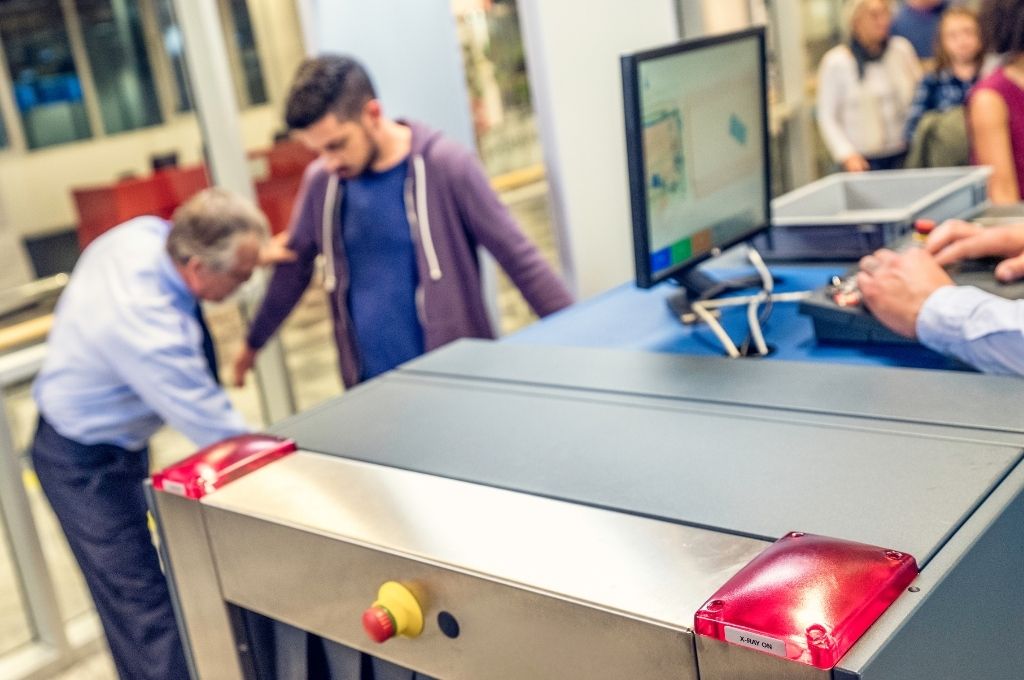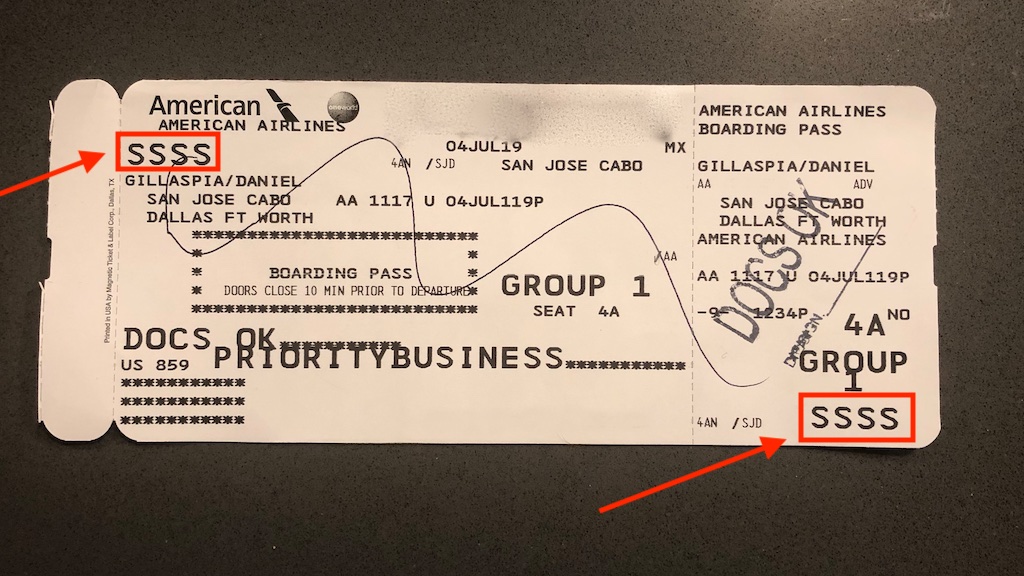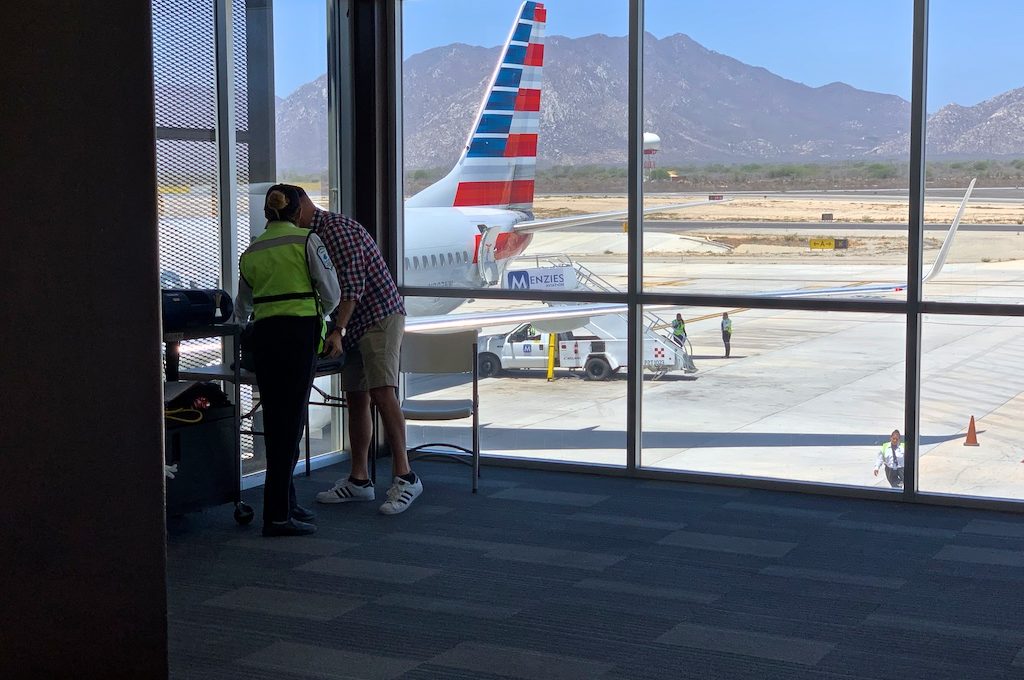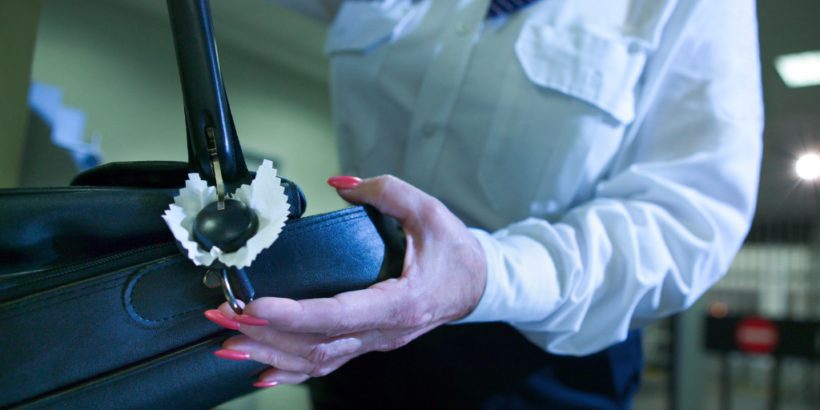If you’ve done a lot of flying, chances are that when going through TSA security you have experienced a good swab or two.
Whether it was your hands or baggage that was swabbed, you may have been curious about what exactly is going on and what are they trying to detect?
Is it drugs, bombs, or is it all just a bunch of security theater?
In this article, we will clear up the confusion about swabbing at airport security and give you some tips on how to deal with it and potentially avoid setting off a false alarm.
Table of Contents
Why is TSA swabbing your hands and bags at airport security?
TSA will swab the hands of passengers as well as their luggage in order to detect traces of dangerous explosives.
When people are dealing with explosive materials, their body and/or belongings will often have very tiny traces of particles or residue of explosives still on them. So TSA uses different methods to detect those microscopic traces in order to screen out passengers who could have intent to do serious harm.
This is the process known as explosive trace detection (ETD) which unfortunately is not a perfect system. Below, we will go into more detail and talk about the shortcomings of the system and how you can deal with them.

When did TSA begin swabbing passengers?
TSA had been swabbing luggage for traces of explosives for a long time but after the failed 2009 Christmas Day bombing of Northwest Flight 253, they soon started to swab the hands of passengers.
(That bombing attempt did not end well for him and he is currently serving four life sentences in a super max.)
Different reasons you might get swabbed by TSA
TSA does not have the resources or the time to swab every passenger so only a certain subset of people will get swabbed.
Suspicious items in your luggage
A common reason that you could be swabbed is that something in your baggage triggers a further inspection. This is often the case if you have a suspicious looking item in your luggage.
This could be some type of electronic or it could be a rare household item like a collapsible tea kettle that just looks strange in the x-ray machine.
You appear nervous or suspicious
If a TSA agent believes that you appear suspicious while waiting in line they could order a swab.
While TSA does not publish a lot of data on how they go about doing this, common sense would dictate that agents would be looking for people who look extra nervous or like they are up to something in order to subject them to more screening.
You refuse the full body scanner
Another reason why you could get swabbed is if you declined to go through the full body scanner. In that case, you will likely be subject to a pat down and could also get swabbed.
Randomly selected
It’s also possible that you could be randomly selected for additional screening.
This could happen without warning or you could see it coming based on your boarding pass. For example, if you had SSSS on your boarding pass then you will have to go through the enhanced screening process which will require swabbing.
When going through the security checkpoint, you’ll usually know that swabbing is coming whenever your bin or bag is removed from the main conveyor belt. The agent will ask who owns the bag and will call you over to where the screening will take place.
Pets
If you are traveling with a pet, you will likely have to get your hands swabbed.
Medical equipment
TSA states that “officers may swab an individual’s hands, mobility aids, equipment and other external medical devices to test for explosives using explosives trace detection technology.”
If you have mobility issues you can always request to have the procedure done while you are being seated to make yourself more comfortable.

How does TSA swabbing work?
Once you have been designated for swabbing, you will likely be directed to walk over to a certain spot at the checkpoint. You will then be asked to hold out your palms and your luggage will likely be set aside on the counter to be swabbed as well.
This can feel uncomfortable and be a bit stressful but if you have nothing to hide, chances are nothing is going to happen and you will be on your way shortly. So just try to follow directions as much as you can.
TSA agents wearing nitrile gloves could use different materials to swab but you will often find them using a fabric swab (perhaps made of teflon coated fiberglass) attached to a wand but sometimes the swabs can be used by hand.
The agents will swab your hands and then will often also swab your luggage contents. It’s not uncommon for electronics like phones, cameras, and laptops to get swabbed but they can also swab your clothing, shoes — pretty much anything.
The TSA agent swabbing your body or your bags has to be very careful to apply just the right amount of pressure to the swab. In fact, despite how easy the swabbing process might look, quite a bit of training goes into showing TSA agents how to properly get a sample.
Depending on the material, TSA could use the same swab up to around 10 times but after a certain point it will become unusable. However, with the outbreak of coronavirus and worries about spreading viruses, TSA gave direction to replace the swab every single time.
(It’s not clear to me if they still have that requirement given how attitudes have changed regarding the pandemic.)
Once TSA has the sample, the sample goes into the ETD instrument.
Typically the instrument uses ion mobility spectrometry (IMS) to get a reading on what the substance is.
IMS works by ionizing the sample and turning a liquid or solid sample into gas particles. Those particles are then sent through a drift tube via an electric field. A detector then records how long it took those ions to get through the drift tube and compares it to other drift times in the library.
Larger ions have more collisions and move slower so these libraries can break down the drift times based on the size and shape of the ions.
TSA has shown interest in moving to mass spectrometry which could be more accurate but is more difficult to build (and to scale) in a small package.
There are also other ways to accomplish EDT but so we don’t get bogged down into the science, let’s get back to the process…..
Once the sample swab is submitted into the detection instrument, it is then compared to a vast library of different chemicals, which only takes a few seconds to happen thanks to powerful algorithms.
If there is a match then the alarm will be triggered. You’ll see a red light come on and hear the dreaded “beep.”
For security purposes, TSA does not release exactly which chemicals they are testing when they check for explosives.
However, to keep your browser search history squeaky clean we have included some possible candidates below:
- Cyclotrimethylene-trinitramine
- Cyclotetramethylene-tetranitramin
- Otoluene
- Pentacrythrite tetranitrate (PETN)
- Ammonium nitrate/fuel oil (ANFO)
- Trinitrotoluene (TNT)
- Nitroglycerine (NG)
- Nitrates
- Trinitrophenylmethylnitramine
- Semtex
If the machine detects traces of an explosive substance, an agent may want to do a second sample to verify that this was not simply a false positive.
After this, you will likely be questioned and depending on your answers and the results of your test, you could be told to go freely about your business or you could be taken to a screening room for an invasive screening.
TSA agents are aware that honest, hard-working people sometimes test positive for explosives so this should not be a “walk of shame” as you head to a screening room. However, it can be difficult to not feel that way.
During the screening process, you could be thoroughly pat down (by a member of the same sex/gender I believe). Your bags could be completely unpacked and every item inspected closely, perhaps getting more swab treatment.
This process could easily add 15 to 20 minutes or possibly longer to your journey through the airport which is why it helps to get there early.

Common items that can trigger the alarm when swab testing
Unfortunately, the explosive trace detection systems can be triggered even when someone has not been in close contact with explosives or does not have any intent to inflict damage.
There are quite a few different scenarios where you could come into contact with something that could set off the alarm and here are some of those.
Products with glycerin
Glycerin can set off the testing machines and unfortunately glycerin is found in a lot of common products.
You can find this in a lot of lotions, certain make up products, soaps, laundry detergents, shaving creams, baby wipes, etc. There are also lots of other products that could contain glycerin.
For some of these products, the odds of you testing positive go up when you use them just before heading through security. For that reason, you should try to wait until after you get through security to apply lotion or any other potentially suspect product.
Fertilizers
If you are a farmer, gardener, or just someone who was randomly exposed to certain fertilizers, those can leave behind traces of molecules that will test positive for explosives, especially if the detection instruments use thermo redox.
Medications
Nitroglycerine pills, used for heart conditions like angina, are allowed by TSA but it’s possible that you could trigger the alarm if you were handling them.
Fireworks and pyrotechnics
If you’ve ever done fireworks for New Year’s Eve or the Fourth of July, and then flown shortly after there’s a chance that you could have tested positive for explosives due to having gun powder residue on you or your luggage contents.
Incendiary munitions, accelerants, firearms, etc.
Sometimes you could be dealing with guns, ammunition, and explosives for some type of training.
This can be really common for military personnel and also police officers, firefighters, etc. If you are dealing with these things, there is a high chance that you would not pass an explosive detection test.
In those cases, the organization you are training with could reach out to TSA at the local airport and let them know that trainees will be going through with explosives residue.
You will still need to show that your name is on a certain list but it could make your time going through the security checkpoint easier.
Machines in need of maintenance?
One thing about these ETD Machines is that they do require maintenance in order to function properly. If a machine has not been properly maintained, it could be more prone to false positives.
So in some cases, you may not have any of the substances above on you but you could still trigger the alarm simply because the machine is not working properly.
Smoking cigarettes?
Some people claim that they have triggered the swab alarm after smoking cigarettes.
I’m not sure if that happens often but you might want to put off smoking cigarettes until after you get through security (assuming the airport has a smoking area).

Do the TSA swabs detect illegal drugs?
One concern that people have is whether or not the swabs will detect illegal drug use.
We know that TSA does not focus on busting people for using drugs. A TSA agent is focused on detecting dangers such as explosives and not on whether or not you are traveling with marijuana or some other drugs.
Also, there could be constitutional concerns if these swabs were used to detect drug use (i.e., used for non-security purposes).
With that said, we know that these type of chemical detection tests can be designed to detect narcotics.
Typically, whenever you see tests like this being used to discover narcotics in a US airport they are being used by US Customs and Border Protection to inspect passengers, luggage, or packages coming into the US.
So I suspect that TSA swabbing is not set up to bust people that have come into contact with drugs.
BUT it is worth noting that whenever you encounter chemical swab testing, there’s always a chance that it could be designed to pick up chemicals related to illegal drugs. This is especially true when traveling through other countries that are known for cracking down on drugs.

Are they swabbing for DNA?
Some people are really worried about their personal security when they are swabbed on their hands.
Their worry is that their DNA is being collected and stored but that is not happening at the security checkpoint. Also, the swab is not used to detect viruses whether that be coronavirus or any other virus.
Related: Can Airlines Refuse To Serve Sick Passengers?

Does TSA always rely on swabbing?
You may not always be swabbed as TSA has contemplated utilizing different methods for explosive trace testing.
For example, they have entertained using contactless methods involving lasers or other methods like moving air particles around. New methods will always require a lot of testing so they may not be used in practice for quite a while.
But it’s feasible that in the foreseeable future swabbing may become more of a rare and obsolete practice.
Why am I always getting swabbed at the airport?
If you’re somebody that’s always getting swabbed by TSA then consider a couple of things.
First, you might be traveling with an object that looks strange in an x-ray machine.
Think about any weirdly shaped items you travel with such as electronics or even certain types of vapes. Traveling with powders can also raise questions.
Second, if you have SSSS on your boarding pass then your name might be in a government database causing you to get enhanced screening. You can apply for a redress number which can potentially remove your name from that list so that you will not get enhanced searches any longer.
Another possibility is that you give off nervous vibes. Some people just can’t help but to look suspicious when they go through security and that can raise red flags. Try to relax and just remind yourself that you are not doing anything illegal.
And finally, maybe you have just had some bad luck and you need to give it a few more tries before you start to worry.
Final word
For most people, getting swabbed at airport security is not a major hassle and it won’t affect your travels much.
However, if you have traces of explosives on you or in your belongings then you could be subject to a much more invasive screening that could take up a considerable amount of time.
So try to think ahead and avoid wearing certain items or exposing yourself to certain substances if possible before you head to the airport.
Additional Sources:
Daniel Gillaspia is the Founder of UponArriving.com and the credit card app, WalletFlo. He is a former attorney turned travel expert covering destinations along with TSA, airline, and hotel policies. Since 2014, his content has been featured in publications such as National Geographic, Smithsonian Magazine, and CNBC. Read my bio.


Absolutely no safety info about the wipes is available. There are reports of reactions with pets that are swabbed.
My dog will snipe at them too.